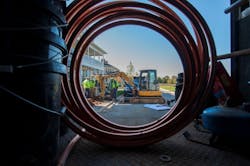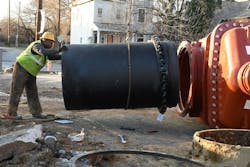About the author:
Vikram Takru is CEO of KloudGin Inc. Takru can be reached at [email protected].
One of the biggest challenges today facing water and wastewater utilities is how to deliver modern mobility and a cross-silo “Single Face of Work” to the last mile that enhances field service, worker productivity and customer satisfaction.
User expectations have increased. People now want, and expect, an “Uber-like” experience. If an incident occurs, such as a pipe or main breaking, customers expect an immediate, trackable response. They do not want to call the field center. They expect to use an app and be notified of the status, especially given the volume of work from home (WFH) customers. Stakeholders are connected 24/7, so service must happen 24/7.
Demands for Digital Transformation
Digital transformation has gained steam lately with utilities due to multiple reasons, including:
- Infrastructure is aging, and it is becoming a greater challenge for utilities to react.
- Utilities are faced with a rapidly retiring workforce. Many retiring workers were doing job tasks and field work where they did not need directions, some for 30 to 40 years.
- The new millennial workforce does not have deep horizontal/vertical infrastructure information. New workers do not want to write on paper, they expect an app to provide everything from driving to layout directions.
- Utilities are being pushed to increase efficiency. There is pressure on business models because ratepayers want rates to go down. Worker time (and overtime) management and productivity has become more critical.
- As water and wastewater operations collect large amounts of customer data, this information must be both utilized for field service operations and protected from cyber-attacks. Hosted and self-built utility systems are not made for advanced data protection or sharing.
- From OSHA regulations and training requirements to environmental, social, and governance (ESG), plus reliable non-energy consumption, regulatory pressure is constant.
These challenges are linked together, but collectively they are solvable with digital transformation.
What is Possible With Digital Transformation & Modern Mobility?
In the past, when there was a leak, a customer made the call, the dispatcher rounded up a crew and they were dispatched to the area to shut the water off and fix the challenge. Sometimes this took days.
Today, with a digitally transformed utility, the crew that is closest to the incident or emergency can be dispatched in seconds to answer the challenge.
At the same time, the back of the infrastructure is becoming smart. Gone are the old ways of door-to-door meter reading. Now with advanced metering infrastructure (AMI) and advanced meter reading (AMR), utilities can receive information and data every two minutes. Utilities can view consumption, patterns, and areas that are trending with use or not. Intelligent IoT sensors and assets, storage and other advanced monitors can collect and send information on leaks. Everything is becoming connected. Even the equipment assets are becoming intelligent.
As utilities collect the data, they can become more aware and predictive in their operations and maintenance. Next generation asset management systems will know what is about to break. For example, a vibration sensor will know when a pump is going to fail. The predictive maintenance application (PdM) will create a workorder and dispatch the closest, available crew with the right training and tools in advance to predictively repair or replace the pump, valves, hydrants, backflow check valves and other infrastructure.
That PdM does not exist in a siloed situation. It is based on combined data and artificial intelligence (AI) and machine learning (ML) capabilities that are available now in cloud-based applications.
Workers-First Solutions For Increased Productivity
The people who produce the field work are technicians and contractors. It is extremely important to give them the information they need about where they need to be and what they need to do. The same goes for the suppliers and customers.
At the same time, the field applications have to be simple to use and easy to access. Mobile digital solutions must provide rugged applications that can be used easily in the field without training for a worker engagement layer. The app needs to be rugged and simple and downloadable and usable without training.
This single scheduling engine will create modern mobility: one single app on a mobile device that works online and offline. This single app delivery will help workers focus on their jobs and increase both productivity and customer service.
The modern mobility app will help field service deployment and workorders to increase efficiency. If a truck is down the street, that crew can be sent real-time to emerging or critical situations. The mobile application will also provide field crews one single view for all types of work that they are doing. This app can also deliver asset location, repair manuals, appointment updates and restrictions, weather info and travel directions.
What Is Coming Next?
First, utilities will begin combining all their field- and asset-oriented (short and long cycle) work into a single scheduling and appointment engine, so work will no longer be siloed.
Secondly, water utilities will focus more on the ratepayer and begin delivering a level of service like Uber with real-time and updated information.
Finally, we are entering an age where data is the next oil. Utilities generate and receive volumes of data. This information on utility assets, customers, usage, workorder productivity, infrastructure, and predictive maintenance will be valuable in creating new revenue streams, value-based service and customer satisfaction.
As a result of digital transformation, a utility’s asset and field service work will be combined and create operational efficiency. The cloud-based application will connect data to the field service crews, customers, partners, contractors, and equipment, while also wiring them all together into one application that will scale up or down with work.
Workloads can be scaled automatically, and the system will be flexible and nimble enough to expand and grow with operational, worker and customer needs. Through this digital transformation, the water and wastewater operation of today will become a utility of the future.
Examples
CalWater had a drought mandate. It had a huge situation when bills went up. It witnessed a surge in customer service for people who were looking for leaks to reduce costs. If CalWater did not have a single optimized appointment scheduling and work order tracking system, it would have not been able to meet the surge. With its digital transformation application, CalWater was able to reduce its work order backlog by 30% and as a result, could service that many more customers.
Water Operations Technician Mike Smith went to do a job at a home after having been routed to the right place and time, digitally. He popped up the iPad and had a work order to turn on the water service at a house. Smith checked the work order as he started to turn on the water, and the moment he went to update its status, the system rejected his input.
He could not complete the work order because the pop-up message said: “If you’re turning on the water at a location, you must have a physical conversation with a resident/owner so there are no water taps open that could flood the house. Otherwise, you cannot turn on the water.”
The application prevented an incident. What used to be in the minds of long-time workers is now built into the system, along with worker safety, customer safety and efficiency processes.

